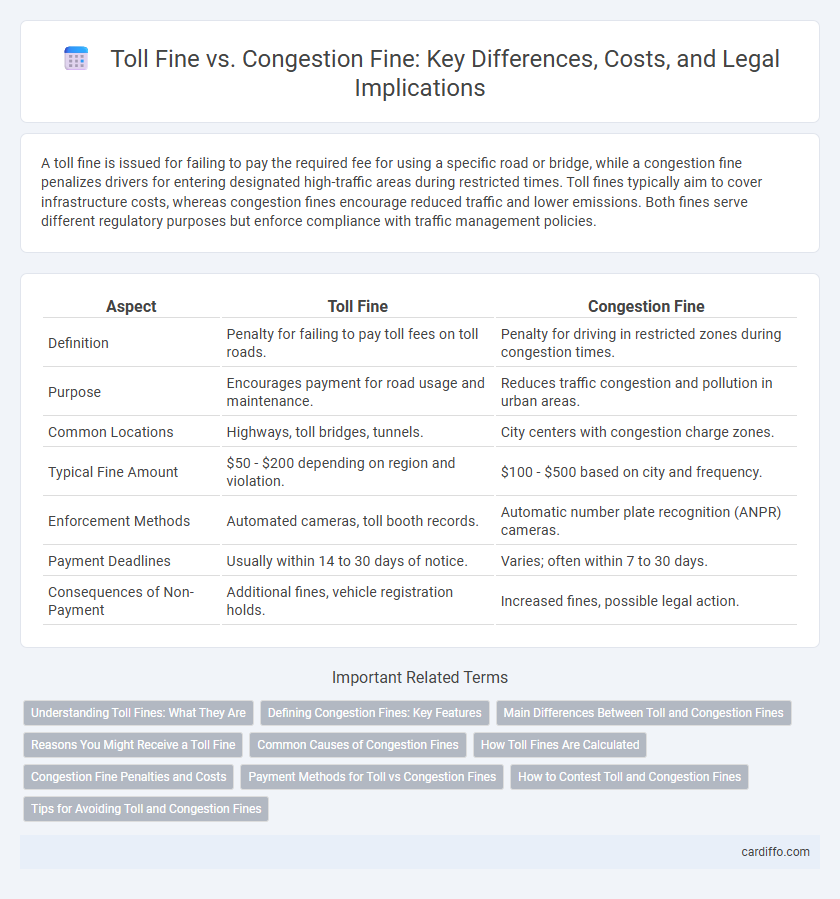A toll fine is issued for failing to pay the required fee for using a specific road or bridge, while a congestion fine penalizes drivers for entering designated high-traffic areas during restricted times. Toll fines typically aim to cover infrastructure costs, whereas congestion fines encourage reduced traffic and lower emissions. Both fines serve different regulatory purposes but enforce compliance with traffic management policies.
Table of Comparison
| Aspect | Toll Fine | Congestion Fine |
|---|---|---|
| Definition | Penalty for failing to pay toll fees on toll roads. | Penalty for driving in restricted zones during congestion times. |
| Purpose | Encourages payment for road usage and maintenance. | Reduces traffic congestion and pollution in urban areas. |
| Common Locations | Highways, toll bridges, tunnels. | City centers with congestion charge zones. |
| Typical Fine Amount | $50 - $200 depending on region and violation. | $100 - $500 based on city and frequency. |
| Enforcement Methods | Automated cameras, toll booth records. | Automatic number plate recognition (ANPR) cameras. |
| Payment Deadlines | Usually within 14 to 30 days of notice. | Varies; often within 7 to 30 days. |
| Consequences of Non-Payment | Additional fines, vehicle registration holds. | Increased fines, possible legal action. |
Understanding Toll Fines: What They Are
Toll fines are penalties imposed when drivers fail to pay required toll fees on highways or bridges, designed to fund road maintenance and infrastructure improvements. These fines differ from congestion fines, which target vehicles contributing to traffic density in designated urban areas during peak hours. Understanding toll fines involves recognizing their role in promoting timely payment and deterring toll evasion to maintain efficient transportation networks.
Defining Congestion Fines: Key Features
Congestion fines are penalties imposed on vehicles entering designated high-traffic zones during peak hours to reduce traffic congestion and improve air quality. These fines are typically calculated based on the time of entry, vehicle type, and emission standards, ensuring that heavier polluters face stricter penalties. Enforcement relies on automated camera systems and license plate recognition technology to monitor compliance and issue fines efficiently.
Main Differences Between Toll and Congestion Fines
Toll fines are penalties imposed for failing to pay the required fee for using specific roadways, bridges, or tunnels, while congestion fines target vehicles that enter designated high-traffic zones during peak times to reduce urban congestion. Toll fines are typically calculated based on the unpaid toll amount multiplied by a set penalty rate, whereas congestion fines are fixed charges intended to discourage driving in crowded city centers. Enforcement methods for toll fines often involve electronic toll collection systems, while congestion fines rely on traffic cameras and license plate recognition.
Reasons You Might Receive a Toll Fine
You might receive a toll fine if you fail to pay the required toll fee within the designated timeframe, often due to forgotten payment or insufficient funds in an electronic toll account. Toll fines can also occur when your vehicle lacks a proper transponder or license plate recognition fails, leading to unpaid toll violations. Unlike congestion fines, toll fines specifically address non-payment of fees for using toll roads or bridges.
Common Causes of Congestion Fines
Common causes of congestion fines include entering restricted zones during peak hours without proper permits or paying the required fees, unauthorized vehicles using bus lanes, and failure to adhere to traffic regulations established to reduce urban traffic. Congestion fines are primarily issued to manage city traffic flow and reduce pollution by discouraging non-essential vehicle use in high-density areas. Ignoring signage, lacking registered electronic passes, and violating time-based entry restrictions are frequent triggers for these penalties.
How Toll Fines Are Calculated
Toll fines are calculated based on the unpaid toll amount multiplied by a predetermined penalty rate set by the local transportation authority. The calculation often includes additional administrative fees and may increase with repeated violations or delayed payments. Unlike congestion fines, which are calculated based on time and location within congestion zones, toll fines focus strictly on usage of toll roads and unpaid fees.
Congestion Fine Penalties and Costs
Congestion fine penalties impose significant costs on drivers entering restricted urban zones during peak hours, often exceeding standard toll fines by substantial margins. These fines are designed to reduce traffic congestion and environmental impact by incentivizing alternative transportation or off-peak travel. Repeated violations can lead to escalated fees, additional administrative charges, and potential legal consequences, thereby increasing the financial burden on non-compliant motorists.
Payment Methods for Toll vs Congestion Fines
Payment methods for toll fines typically include online portals, mobile apps, and payment kiosks, allowing rapid settlement with debit or credit cards. Congestion fines often provide similar digital payment options but may also accept payments via postal mail or in-person at municipal offices. Both fines emphasize convenience and immediacy to encourage timely payment and reduce penalties.
How to Contest Toll and Congestion Fines
To contest toll and congestion fines, gather evidence such as payment receipts, timestamped photos, or GPS data proving valid use or exemption. Submit a formal appeal through the local transport authority's online portal or by mail, clearly explaining your case and attaching supporting documents. Ensure compliance with deadlines, usually within 28 days, to increase the likelihood of a successful dispute.
Tips for Avoiding Toll and Congestion Fines
To avoid toll and congestion fines, always ensure your vehicle is registered with the appropriate toll payment system before entering toll roads or congestion zones. Use apps or GPS devices that provide real-time alerts for toll boundaries and congestion charge areas to plan your routes effectively. Regularly review local traffic regulations and payment deadlines to prevent inadvertent non-payment and costly penalties.
toll fine vs congestion fine Infographic

 cardiffo.com
cardiffo.com